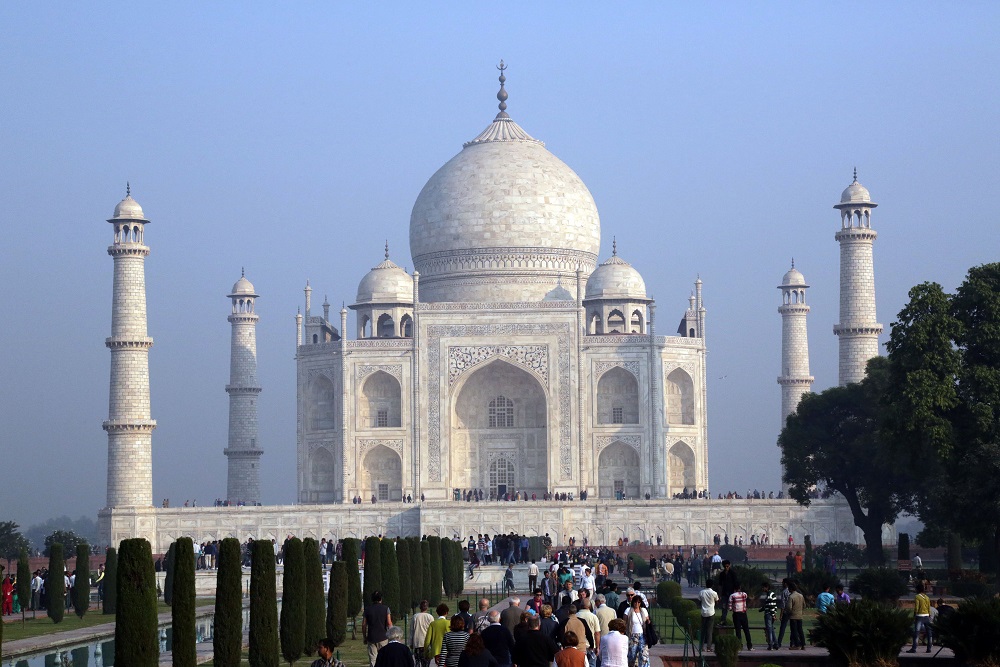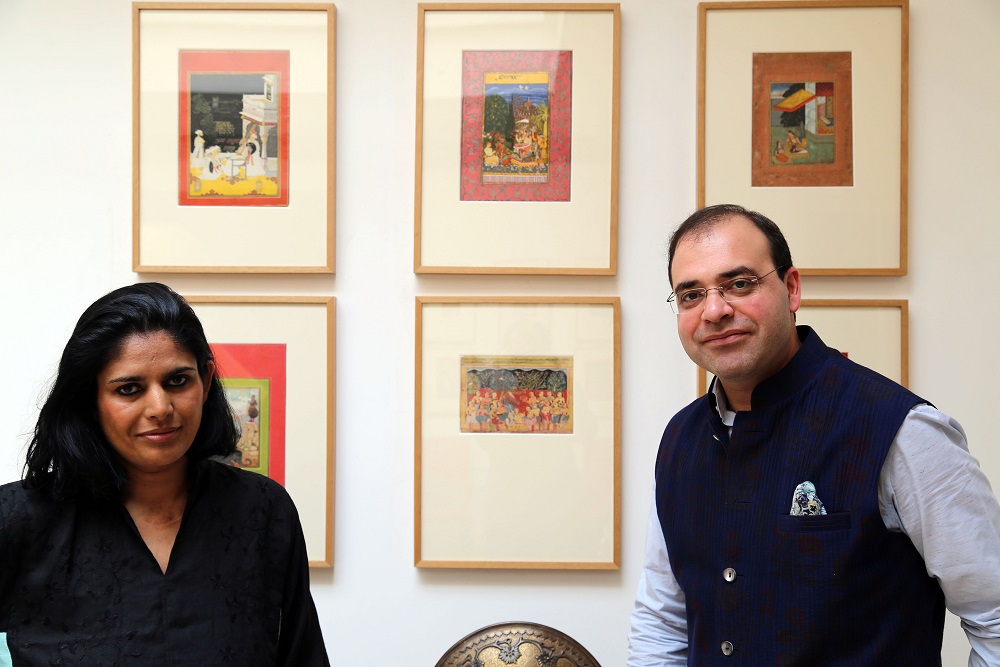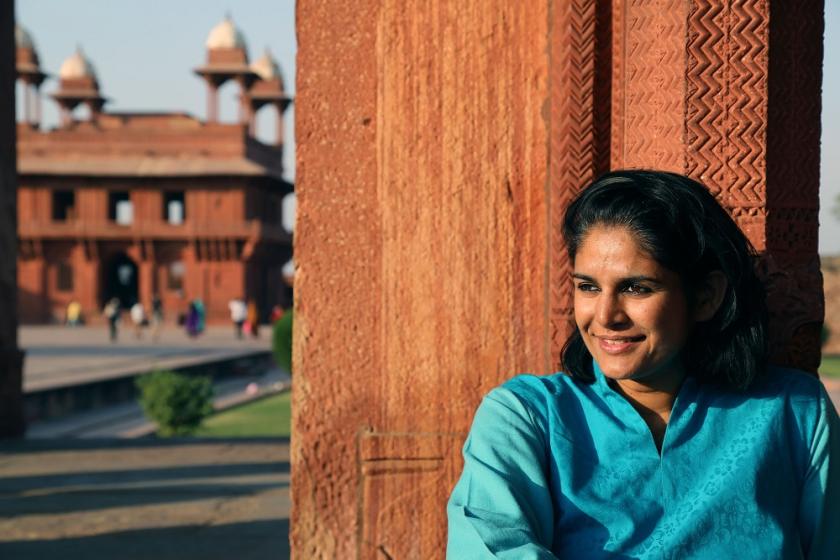The BBC India Season is bringing us a cluster of programmes amounting to a fascinatingly varied series of visits to the subcontinent. Incidentally, and not coincidentally, there is also an India Festival with myriad exhibitions, conferences and lectures at the Victoria and Albert this autumn.
Sona Datta began her career at the British Museum and is now the lead curator at the Peabody Essex Museum in Salem, Massachusetts, the most important museum in the USA that Europeans have never heard of, which has significant holdings in Indian art. British by birth, Bengali by heritage, she is enthusiastic, immensely knowledgeable and combines the outlooks of both insider and outsider. Her trilogy of programmes, of which this – The Other Side of the Taj Mahal – was the second, is much more than just a highly intelligent and visually beguiling tour of the great buildings and arts of India. It is a subtle and even provocative visual history of some 5,000 years of waves of migration, of empires built and lost, of different cultures and religions living together at times in amity, at times in open warfare.
Akbar determined to tolerate and even welcome all manifestations of religion in his empireHer first episode, Pakistan Unveiled, set the scene with a revelatory look at the remnants found by archaeologists of the sophisticated cities of the Indus Valley civilisations in Northern Pakistan from some 5,000 years ago: Harappa was not only a city of some 80,000 set out on a grid pattern, but there is evidence in sculptural fragments that the Indus Valley cultures worshipped powerful women. Millennia later one of the most famous conquerors of history, Alexander the Great, paid a visit (in 330 BC) altering the culture by leaving a legacy of Indo-Hellenistic art. The ruins of Buddhist monasteries and sculptures (now rescued to be shown in museums) demonstrate the wealth of the succeeding rich trading Indo-Greek cultures of northwest Pakistan, known as Gandhara, and the visual fusion that created some of the most beautiful stone sculptures in art.
This follow-on dealt with the period most familiar to westerners, that of the great Mughal emperors. The famous and infamous ancestors of Babur (1483-1530) included Tamerlane and Genghis Khan, and Babur was not averse himself to conquering new lands, sweeping into the north of India (Henry VIII was ruling England at the time). Centuries on, his great-great-great-grandson, the fratricidal military genius and master of intolerance, Aurangzeb (1618-1707) had neither understanding of nor care for the culture and liberalism that had made his dynasty great.
We started in Lahore: Babur, the Muslim from Central Asia, was forthright in his condemnation of what he found there – ugly people, who could not provide good food, dogs or horses, although he was naturally attracted to the region’s large natural resources of gold and silver. He proceeded in an astonishingly short time to turn Lahore into a garden city with marvellous monuments and water features, some of which remain today: the garden, then as now, an earthly paradise. As a young Pakistani musician and scholar remarked in the first episode, the region is politically very young and culturally very old, its first cities going back five millennia. From Lahore, the Mughals pushed onwards into the vast subcontinent which derived its name from the river Indus.
 It was a turbulent world: Babur himself battled ferociously with alcohol, at one point destroying many of his literally priceless drinking vessels, themselves a high point of Mughal art, and distributing their valuable remnants to the poor. The reign of Babur’s grandson and successor, Akbar, was perhaps the most sympathetic and mysterious of all. Six hundred kilometres to the south of Lahore, Akbar built the Red Fort in Agra, another great monument, and nearby the redstone city of Fatehpur Sikri which was eventually mysteriously abandoned, but remains an architectural wonder. He and his court were ardent huntsmen, herding together huge varieties of wild animals for the pleasure of killing them. A thousand cheetahs were trained to hunt, as westerners might train dogs.
It was a turbulent world: Babur himself battled ferociously with alcohol, at one point destroying many of his literally priceless drinking vessels, themselves a high point of Mughal art, and distributing their valuable remnants to the poor. The reign of Babur’s grandson and successor, Akbar, was perhaps the most sympathetic and mysterious of all. Six hundred kilometres to the south of Lahore, Akbar built the Red Fort in Agra, another great monument, and nearby the redstone city of Fatehpur Sikri which was eventually mysteriously abandoned, but remains an architectural wonder. He and his court were ardent huntsmen, herding together huge varieties of wild animals for the pleasure of killing them. A thousand cheetahs were trained to hunt, as westerners might train dogs.
Such scenes were celebrated and memorialised in vivid colourful miniatures, no detail too small to be carefully delineated. But one day Akbar had a fit – either a seizure or an epiphany: the result was that all the wild animals brought together for a hunt were released back into their natural habitats. Akbar determined to tolerate and even welcome all manifestations of religion in his empire: Buddhism, Hinduism, Jainism, and the mystical, celebratory all-singing, all-dancing branch of Islam, Sufism. There were, said the enlightened Emperor, many pathways to god.
Akbar’s grandson Shah Jahan – his name meant “the glory of the world” – was best known for creating the grandest monument to love set in stone, the Taj Mahal, in memory of his favourite wife, Mumtaz Mahal. She died at the age of 38 giving birth to his 14th child; the Emperor mourned for two years, and called in the skills of Indian craftsmen, Baluchistan stone-cutters, Persian calligraphers and architects from the Ottoman Empire to create the marble mausoleum, a fantasy of what might be the royal dwelling in paradise. The Taj Mahal (pictured above) was described by a poet as a teardrop on the cheek of time, and our empathetic narrator confided that she had first seen it when she was only eight, and every time she visited, the thrill never lessened.
 The courts of the Emperors demonstrated, in Datta’s phrase, the changes of methods and cultures, from the roving entourages of Babur, the outward-looking symposia and endless discussions of the enlightened Akbar, and the massive buildings of marble of Shah Jahan. And then disaster struck in the form of the unloved and rejected son, Aurangzeb, who not only imprisoned his father but toppled his principled but weak older sibling, Dara Shikoh, from the throne and had him murdered in the most gruesome way imaginable. He was also ferociously intolerant.
The courts of the Emperors demonstrated, in Datta’s phrase, the changes of methods and cultures, from the roving entourages of Babur, the outward-looking symposia and endless discussions of the enlightened Akbar, and the massive buildings of marble of Shah Jahan. And then disaster struck in the form of the unloved and rejected son, Aurangzeb, who not only imprisoned his father but toppled his principled but weak older sibling, Dara Shikoh, from the throne and had him murdered in the most gruesome way imaginable. He was also ferociously intolerant.
To act at times as profoundly unwilling hosts to invaders and empire-builders has been the subcontinent’s fate, and the programme ended with archive of the 20th century British Raj, unsympathetic to and uninterested in the indigenous cultures, which followed an ultimately disastrous policy of divide-and-rule, setting adherents of Islam and Hinduism against each other, and not smoothing over the animosities of rival principalities. There were brief but harrowing glimpses, dramatic in black and white in contrast to the sumptuous colour of the programme’s photography, of the riots and deaths of the times of independence and partition in 1947.
Datta also queried the ultimate value of the three centuries of the Mughal Empire, as it moved from tolerance to repression. Her view was that India still struggled with religious and cultural identity, and that in the shared history of the whole subcontinent one could not understand one country, Pakistan, without the other, India.
In the hands of this highly intelligent and involved guide, we were treated to more than just the sight of glorious buildings and gorgeous paintings; more than art history, this was history in every sense (her interviewees included many cultural practitioners and commentators: Datta with collector and critic Nitin Bhayana, pictured above). Even the music by Nainita Desai and Malcolm Laws added to the emotive atmosphere, the photography by Spike Geilinger, from markets and alleyways to gardens and tombs, always apposite, and the whole excellently woven together under the oversight of Hugh Thomson. We have Datta’s final instalment, Of Gods and Men, to look forward to next week.















Add comment